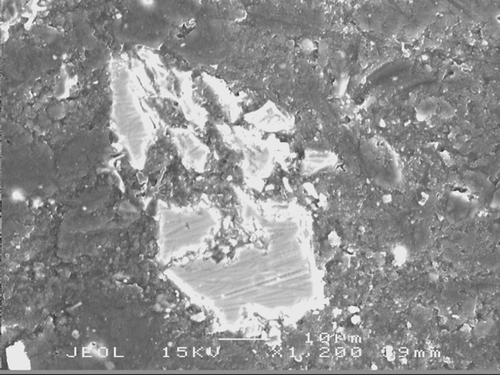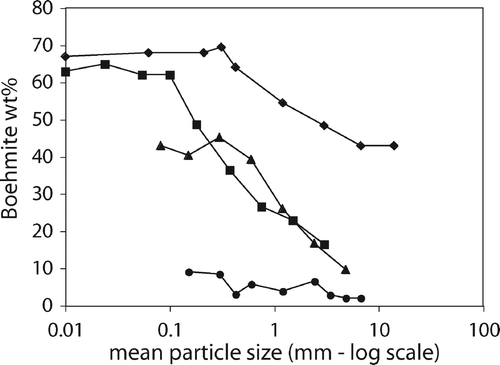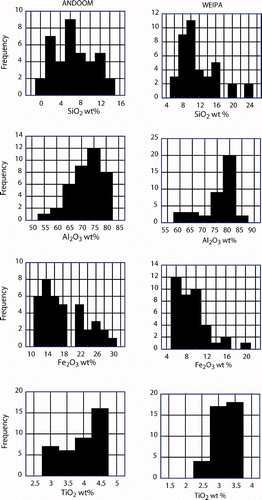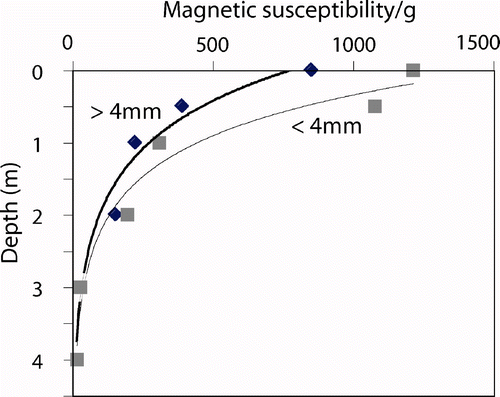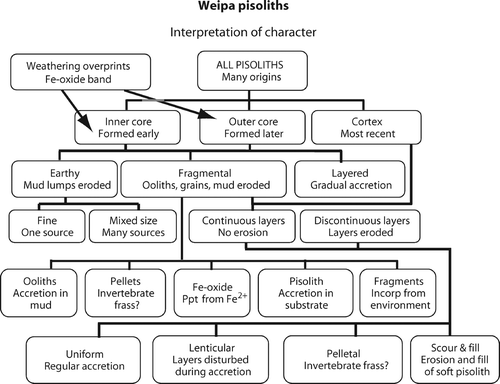Abstract
The extensive bauxite deposits of the Weipa region, northern Queensland, are a loose agglomeration of nodules, pisoliths, ooliths and fine material, with a mean particle size of 5 mm. Only about 5% of the deposit is finer than 0.1 mm, about 5% is coarser than 10 mm, and the bulk of the deposit is made up of pisoliths and ooliths. The Bauxite is overlain by soil that in most places is mixed with the upper portion of the Bauxite over about 30 cm. There is little more than 20 m of relief across the deposit; in some drainages the bauxite is overlain by or contains within it unconformably ‘redsoil', a fine-grained oolitic facies, rich in Al2O3. The Bauxite overlies a ferricrete with a sharp or gradual contact. In the latter case the Bauxite contains soft earthy pisoliths mixed with pisoliths similar to those in the body of the deposit. Pisoliths have a core which may be a lump made of any of the materials of the deposit; earthy pieces, accumulations of ooliths, a fragment of a broken pisolith, or a small pisolith or oolith. The cores are surrounded by up to seven cortices distinguished by various shades of red-brown-yellow from almost white to dark red. The cortices may be continuous around the core, or discontinuous. Pisoliths have been classified on the basis of these characteristics, and the features interpreted to indicate that the cortices form largely by accretion and that many have undergone transport and erosion during their formation. The pisoliths are composed of gibbsite, boehmite, nano-particulate anhydrous aluminium minerals, kaolinite, quartz, hematite and/or goethite in widely varying proportions and about 2% anatase. The deposit at East Weipa sits on Paleogene sands and clays of the Bulimba Formation; this bauxite contains up to 30% quartz and of the order of 5% Fe2O3. The deposit at Andoom, north of Weipa overlies Rolling Down Group smectitic/vermiculitic sandstones; the bauxite contains little to no quartz but up to 25% Fe2O3. In both deposits the gibbsite:boehmite ratio increases with depth through the bauxite, and kaolinite and quartz decrease in amount down the profile until the base. Both deposits contain, on an anhydrous basis, about 75% Al2O3, 10% SiO2, from 10 to 20% Fe2O3 and 3% TiO2. Distinguishing the bauxite from the two deposits is easiest using the abundance of quartz and less easily by the Al:Fe ratio which is lower at Andoom than at East Weipa.

Introduction
In companion papers, Taylor et al. (Citation2008), described the general features of the Weipa bauxite deposit, its landscape setting, regolith profile, climate and previous research. Then, Eggleton et al. (Citation2008a) described in detail each component of the regolith profile at East Weipa and Andoom from the bedrock—Rolling Downs Group (Andoom) or Bulimba Formation (East Weipa)—through saprolite and plasmic zone to the mottled zone and overlying ferruginous kaolinite or ironstone immediately below the pisolithic bauxite ore, and concluded that the profiles, at least to the base of the pisolithic bauxite, were in situ. They reported also that the bauxite itself was made up of essentially uncemented, loose pisoliths.
The bauxite is extensive, covering of the order of 10 000 km2 of western Cape York Peninsula to a depth between 1 and 6 m. It is composed of about 80% loose gibbsitic pisoliths with ooliths, dust and a few large fragments making up the rest. There are minor areas of cemented pisoliths and fine-grained ore (locally referred to as ‘redsoil’). This is a huge volume of loose pisolithic material ( ) which largely remains undescribed in the literature, and its presence is also not adequately explained.
Figure 1 (a) High eastern wall (about 6 m) in the Ash pit at Andoom in the Rio Tinto Aluminium mine. Note the ready collapse of the wall and accumulation of loose pisoliths at the base of the face. (b) Mine face in the Emperor pit, East Weipa showing loose pisolith accumulation and variegated colour associated with tree roots. (c) Jewfish pit, East Weipa showing a much paler colour than (a) and (b). The horizontal benches represent former levels of water that fills this mine pit during the wet season. (d) High-Fe bauxite of the Jacaranda pit, Andoom.
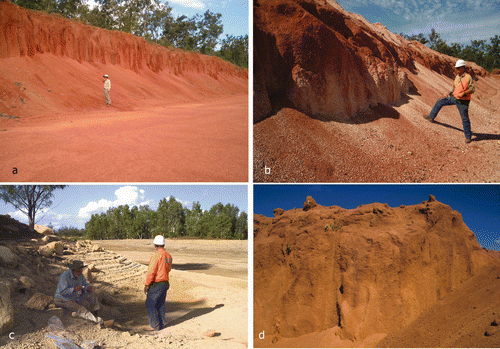
The origin of pisoliths is a controversial subject globally, let alone at Weipa which is probably the world's largest single accumulation of these enigmatic regolith materials. The only detailed description of Weipa pisoliths is from Morgan (Citation1995), but it does not explain their chemistry or mineralogy in any detail, nor their genesis.
It is not our intent to outline all the ideas relating to pisolith formation here, but it is necessary to review a few of the more significant hypotheses. Nahon (Citation1991) described the process of glaebulisation (pisolith core formation) as involving the movement of elements and their precipitation at a place in the finer-grained matrix of the regolith. These movements, Nahon contended, are controlled by the pore-size of the fine-grained matrix with movement being from coarse to finer pores. The result is the formation of a ferruginous glaebule Footnote*, the minerals of which have replaced the original fined-grained matrix minerals with Fe-oxyhydroxides in an isovolumetric fashion. A cortex to these glaebules develops to form pisoliths by transformation of the core (glaebule) to cortical layers progressively from the outside the glaebule, even to the point where no sign of the original glaebule is evident, or by the replacement of the hematitic glaebule by alternating layers of more and less aluminous goethite. His stages in formation of pisoliths are illustrated in Nahon (Citation1991 .14, p. 157).
Tardy's (Citation1997) book on laterite contains much of interest to this study, particularly from the extensive research done by the French worldwide. Here we simply outline his hypothesis for the genesis of pisoliths in bauxite. He reported (p. 287):
‘Pisolites are formed in the most mature bauxites at the same time as boehmite develops. Boehmite is sometimes formed at the centre of a pisolite, while hematite is pushed to the edges of the cement. Boehmite sometimes appears in the cement and hematite is concentrated in the central rings. Boehmite and hematite are individualized in very small crystals in metabauxite [Weipa is a metabauxite according to Tardy]. This mechanism results in the formation of pisolites.
However, as in ferruginous cuirasses, the surface horizon is often dehydrated (BoulangéCitation1984) [see Tardy Citation1997 5]. In the first case hematite and kaolinite are transformed to aluminous goethite. In the second boehmite is rehydrated to gibbsite. It appears that rehydration accentuates the development and individualization of pisolites. As in ferruginous cuirasses, the surface of the bauxite plateaus is strewn with gravel. Bauxites are dismantled from the top and reconstituted at the bottom.'
Tilley (Citation1994) investigated the origin of pisoliths at Weipa. He concluded that some pisoliths form from precursor ferruginous-kaolinitic nodules, especially those with quartz-rich cores. Others with concentrically banded pisolithic fabrics and particularly those with vitreous cores evolve in a manner similar to that proposed by Nahon (Citation1991) except he suggested alumina accumulates rather than iron during centripetal three-dimensional glaebulisation. He suggested those with vitreous cores (akdaleite and/or eta-alumina) are formed by the epigenetic replacement of what was originally kaolinite. Tilley also argued that there is a continuum between single pisoliths and larger compound pisoliths and that one may agglomerate or degrade to form the other. Tilley also recognised internal unconformities and suggested they result from episodes of pisolith formation.
In this paper we describe our observations of the bauxite zone of the Weipa weathering profile and discuss them in an effort to explain their origin.
Materials and Methods
The Bauxite Zone of the weathering profile of the Weipa Plateau has been examined at about 50 localities, mainly in mine pits at East Weipa, Andoom and Skardon River, but also in breakaways and in sea cliffs and roadside borrow pits. From these localities the overall features of the pisolithic bauxite have been observed. The repository for all figured samples (with ANU numbers) is the Department of Earth and Marine Sciences museum, Australian National University, Canberra.
Many thousands of pisoliths and nodules have been externally and internally examined, in the field, in the laboratory, and by optical microscopy and scanning electron microscopy (SEM) and more than 900 have been described in detail microscopically at magnifications of x20. Pisolith size has been measured through the bauxite profile.
The qualitative descriptive data on pisolith internal fabrics characteristics have been used to develop a classification for pisoliths at Weipa.
For detailed mineralogical examination, samples were taken at 0.5 m intervals from a 4 m-high recently exposed bauxite pit profile in the Jacaranda pit Andoom, and at 0.35 m intervals from two profiles in the Grunter pit, East Weipa (see Eggleton et al. Citation2008 for locality details). Samples from redsoil profiles at Andoom were taken from the Oak, Meeka and Messmate pits.
At Jacaranda, the bauxite was lightly cemented in the upper 2 m, sufficiently strongly to maintain a near-vertical profile, but the bauxite readily fell into individual particles upon disturbance. Cementation was not evident at the Grunter pit.
Samples were initially sieved into four fractions: >19 mm. 19–9.6 mm, 9.6–4 mm, <4 mm. Later sieving of the Jacaranda and Grunter B samples were made at φ or φ/2 intervals [φ = –log2(diameter) in mm] from 8 mm to 125 μm, with some finer fractions extracted from the 0 and 1 m samples at Jacaranda. Redsoils were sieved at intervals 9.6, 4, 2, 1, 0.6 and 0.08 mm. The <4 mm fraction from Jacaranda depth 0 m was disaggregated by ultrasonic vibration in water. A fraction <2 μm was extracted by settling the coarser material, then centrifuging the suspension.
Aspect ratios for some pisoliths were determined by micrometer measurement of three perpendicular diameters yielding a maximum (max) a minimum (min) and a mean (=average of max and min). A measure of sphericity (S) was calculated from the relation: S = (max – min)/mean.
Specific gravity or density of the particles was measured by four methods, depending on sample size. Large ellipsoidal particles (>4 mm) were measured by micrometer on three perpendicular axes, weighed, and the density calculated from the volume, assuming an ellipsoidal shape. The specific gravity of these, and other pisoliths were measured by weighing in air, then suspended in water on a top-load balance, and the specific gravity calculated by Archimedes method. The specific gravity of particles between 4 mm and 250 μm in diameter was measured by pycnometry. Ooliths between 1 mm and 200 μm were sized, then selected for sphericity by rolling down a gentle slope followed by hand-picking, then arranged in a line at the bottom of a 75 mm long V-shaped trough. Their mean diameter was determined by dividing 75 mm by the number of aligned ooliths, and their total weight determined to 0.0001 g. From these values a mean density was calculated.
In order to assess the composition of the cores of pisoliths, samples from two East Weipa localities at two depths were tumbled in a gem tumbler in a slurry of coarse carborundum powder and quartz pebbles for approximately two days.
All mineralogical compositions were determined by X-ray diffraction, using Co Kα radiation in a Siemens D5005 diffractometer scanning at 0.5°/minute (fine focus tube) or 1°/min (broad focus). Samples were mixed with an internal standard. Results were processed by the proprietary software SIROQUANT. Any mineral found in any sample was included in the refinement of all, even though in many instances the technique returned zero or very low amounts. In essence, all bauxite samples are composed of no more than seven major minerals: gibbsite, boehmite, hematite, goethite, quartz, kaolinite, and a so-called ‘amorphous’ phase. Tilley & Eggleton (Citation1995, Citation1996) have shown that the Weipa bauxite contains at least two alumina minerals of nanometric particle size, which yield very poor X-ray diffraction maxima. We refer to these, and to ferrihydrite, as ‘poorly-diffracting material.’ The incorporation of a standard allows the amount of poorly-diffracting material to be estimated. Minor minerals present in some, if not all, samples are anatase, rutile, maghemite and zircon. The SIROQUANT software commonly reports between 0 and 1% of these minerals, though examination of the trace may show no real evidence for that mineral. Amounts greater than 1% are more reliable, but the computed percentages are somewhat dependent on operator experience and on the sequence of refinement steps. We used a consistent methodology to ensure comparable results. Ideally, the SIROQUANT estimation of the internal standard is equal to the amount added, provided no unidentified minerals, including poorly-diffracting material, are present. If poorly-diffracting material is present, the standard estimate will be greater than the amount added. For a number of scans SIROQUANT calculated the standard content to be between 0 and 2% less than the amount added. This we take to reflect the precision of the technique. Where the amount of standard estimated exceeded that added by more than 1%, poorly-diffracting material was assumed and its content calculated. We quote all results to the nearest 1%.
Mineralogical compositions were obtained for the four initial sieve fractions, and bulk composition calculated from these. Later sieve fractions (closer spaced size intervals) were individually analysed. Distribution of minerals through pisoliths was assessed in various ways, some were drilled to extract samples of cortical zones, and some were spalled by immersion in liquid nitrogen followed by plunging them into boiling water. Successive spalled shells (up to three) and the remaining core were analysed by X-ray diffraction.
Particle chemical composition was determined by electron microprobe using a JEOL 650 scanning electron microscope.
Magnetic susceptibility of crushed bauxites was measured in a magnetometer (B. Pillans, analyst, Australian National University, Canberra). Approximately 4 g of sample, loosely packed in a 2 cm cubic perspex box, was measured, and the results normalised to relative susceptibility/g.
14C dating was of redsoil material was undertaken at the Australian National University Radiocarbon Laboratories (ANU numbers 10088 and 10259–10261).
Description of the Bauxite
Particles in bauxite
Except for minor cemented zones, the bauxite is made up of loose, or free-running, particles. There are five kinds of particle; three are entities with characteristic shape and properties, the fourth and perhaps fifth are fragments of the other three: (i) nodules are the largest particles, between about 60 and 10 mm across; (ii) pisoliths form the dominant size fraction (by weight and volume); they range in size from 10 mm to 2 mm; (iii) ooliths in the bauxite are from 2 mm to about 250 μm in diameter and are very nearly spherical; (iv) fines are smaller than 250 μm; and (v) quartz and bauxitic sand, fine sand and silt; and dust, material <75 μm. Larger fragments have enough recognisable features to identify them as fragments of (i) to (iii). Pellets are rounded but not spherical white or brown particles. We know little of material (v) except that it is composed largely of gibbsite and boehmite and there is not much of it (≪5%).
All of the first three kinds of particle have one character in common: one or more outer cortices or layers, commonly with highly contrasting colour ( ). The outermost cortex is generally softer than those within.
Figure 2 Corticated particles from the Weipa bauxite. (a) 25 mm nodule, East Weipa. (b) 20 mm pisolith, East Weipa. (c) 10 mm pisolith, Andoom. (d) 5 mm pisolith, East Weipa. (e) 1.7 mm oolith, Andoom (scale bar 1 mm).
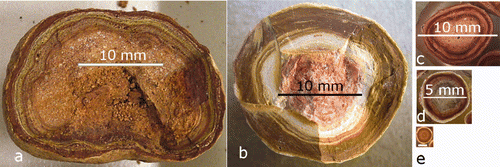
Each of the first three kinds of particle is easily distinguished from the others through several characters other than size, and these are described below.
Bauxite facies and structures
Within the Bauxite Zone it is possible to recognise three major facies and one minor facies: (i) massive bauxite which is a structureless accumulation of nodules and pisoliths with minor amounts of ooliths and dust; (ii) cemented bauxite where lenses and layers of massive bauxite are cemented to a degree requiring a vigorous hammer blow to break it; (iii) redsoil or reworked bauxite which is generally finer than the massive bauxite and sits on an erosional boundary with the massive bauxite; it occurs as lenses on or within the massive bauxite; and (iv) Mn-pisoliths (minor facies) occur at the base of the Bauxite Zone in Chin Chin pit; they are quite unlike the aluminous pisoliths mineralogically, geochemically and in their internal fabrics.
Perhaps the most striking feature of the Bauxite Zone is that there is very little systematic internal organisation. The pisoliths, nodules and fine-grained components are not systematically distributed in the profile for the most part. Exceptions are the occurrence of erosionally based graded beds within the redsoil at Jacaranda in Andoom, and evident bedding in coarse reworked bauxite.
Other far more common structures in this zone include bioturbation features. Root tubules filled with pisoliths and soil from above are relatively common as are cemented root tubules where the margins of the tubules are cemented and often slightly chemically reduced (see Eggleton & Taylor Citation2008a).
The upper region of the Bauxite Zone contains up to 20% particles larger than 8 mm, most of which are nodules or fragments of nodules although they occur in varying abundance through the profile.
Nodules
At the top of the Mottled Zone nodules are largely irregular particles having a weakly developed cortex and an earthy or sandy interior ( ). These are largely composed of kaolinite (60–70%) with goethite + hematite from 10 to 20%, up to 10% gibbsite, and at East Weipa about 5% quartz. At the base of the bauxite similar-looking nodules have somewhat more developed zonation, but with kaolinite reduced to of the order of 10–20% and gibbsite up to 80%. Throughout the main part of the bauxite nodules are very different from those at the base. They are ovate, ranging in size from 25 to about 35 mm long and having diameters from 15 to 25 mm. They are hollow (), with a wall about 5 mm thick.
Figure 3 (a) Nodules in the Mottled Zone from a borrow pit 15 km east from Weipa (the white strip is a pen). (b) A nodule from the base of the bauxite, Jewfish pit, East Weipa (scale in mm).
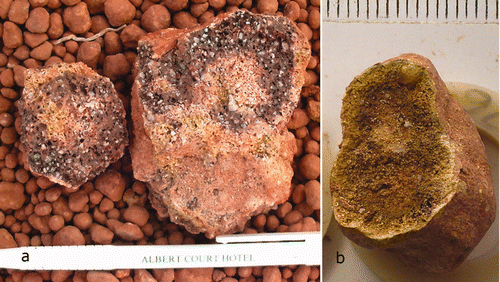
Figure 4 Ovate nodule from East Weipa. (a) Showing the dimple at the right hand end (scale in mm) (ANU 54074). (b) A broken nodule showing the interior (scale in mm) (ANU 46620). (c) X-ray tomographic slice through a similar sized nodule which had no apparent external evidence for a hole (ANU 54073). The image shows a plugged dimple at the end of the nodule, and that the nodule is largely filled with bauxite pisoliths, ooliths and fragments. Spectral colours relate to X-ray opacity: red, most transparent. Image acquired by Michael Turner at the micro-X-ray facility, Department of Applied Mathematics, Australian National University, Canberra.

The cavity may be empty, partly filled, or packed full of very weakly cemented smaller particles (pisoliths, ooliths and fragments). Partly filled nodules tend to have the particles weakly cemented together as a geopetal fill in the cavity. The particles of filled nodules mostly lose any cohesion upon slight disturbance, and such nodules are known locally as ‘rattlers’ or ‘mothers’ ( ). The shell is composed mainly of finer fragments and ooliths, cemented together, such that the nodule requires a hammer-blow or a diamond saw to open it. Filled nodules generally have evidence for a hole toward one end; in most cases the hole shows only as a dimple (). The hole is generally circular, about 5 mm or so across, and is either at one end of the nodule, or offset by up to about 20° from the long axis. Empty nodules never have a hole; nodules containing dust and ooliths have a small hole commensurate with the size of the larger ooliths within. Over the whole deposit, such nodules make up in excess of 80% of all nodules. Ovate nodules are described and discussed at greater length in Eggleton & Taylor (Citation2008a).
Pisolith descriptions
No two pisoliths are the same, yet many have similar internal fabric characteristics. The most obvious features of the pisoliths are their remarkably uniform size across both the East Weipa and Andoom deposits (see below) and their cortical layering. The character of the cortical layering ranges widely. A few pisoliths show a sequence of concentric layers extending inwards to the limit of binocular microscope resolution ( ). We call these simple layered pisoliths. Most pisoliths are much more complex, with a few outer cortical layers enclosing discontinuously layered fragments or unlayered interiors (–h). We refer to the cortices of a pisolith as including those layers from the outside in to the first major discontinuity. Everything inside that discontinuity we refer to as the core.
Figure 5 Pisoliths and ooliths from the Jacaranda pit (Andoom) and the Grunter and Jewfish pits (East Weipa) showing the features described in the text and used in the classification of pisoliths in . (a) Complex pisolith from Jacaranda at 2 m (ANU 46580) showing a cortex surrounding an outer and an inner core. The inner core (1, 2) is distinguished on the basis of terminating cracks at the outer edge of 2. The outer core (3, 4) similarly is defined by terminating cracks. The fretted outer edge of 3, and the sharp colour change between 3 and 4 point to the occurrence of a significant event at this boundary. Concentric banding in cores 2, 3 and 4 suggest they are former cortices. Cores 1, 2 and 3 are vitreous. (b) Small uniform layered pisolith from Grunter at 2.7 m (ANU 46582). An earthy inner core (1) is surrounded by a concentrically zoned outer core (2), the edge of 2 defined by crack termination. (c) Pisolith from Jewfish (ANU 46621) showing an irregular red-brown overprinting (arrowed) on the outer part of its core. (d) Pisolith from Grunter at 1.4 m (ANU 46582), having a broken pisolith as its inner core (1) with a narrow red concentric zone around it defining the outer core (2). Beyond the outer core is a concentrically zoned cortex. (e) Several ooliths from Jacaranda at 0 m (ANU 46580), showing fragmental (F) and earthy (E) cores. (f) Scour and fill (arrowed) in a pisolith from Jacaranda at 0 m (ANU 46580). (g) Pisolith with an earthy fine core and a single cortex from Jacaranda at 3 m (ANU 46580). (h) Oolithic cored pisolith from Jacaranda at 0 m (ANU 46580). (i) Pisolith from Jacaranda at 0 m (ANU 46580) having a fragmental Fe-oxide core and showing uniform cortices and a lenticular cortex. (j) Pisolith from Grunter at 1.4 m (ANU 46582) having a layered core. The core is paler coloured and heavily cracked, terminating in an irregular surface exhibiting scour and fill. (k) Several pisoliths from Jacaranda at 3 m (ANU 46580). The central pisolith has pellets (arrowed) in an earthy mixed size core, and three surrounding pisoliths have Fe-cores. (l) Oolithic-cored pisolith from Jacaranda at 0 m (ANU 46580). (m) Pisolith from Grunter at 1.4 m (ANU 46582) showing a discontinuous layer (arrowed). (n) Pisolith from Jewfish (ANU 46621) showing an earthy core and continuous layers in its cortex.
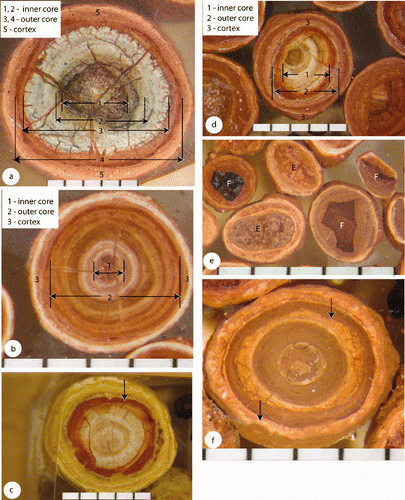
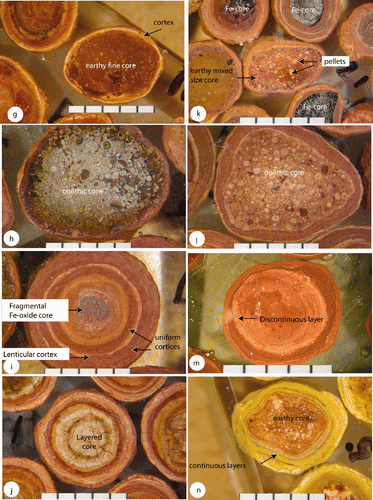
Many fabric groups of pisoliths can be recognised ( ). Nearly all have a core and a cortex; most have a complex core made up of several generations of mineral accumulations ( ). The pisolith in has a fragmental inner core with a layered outer core and three to four cortical layers around the circumference. Note also that the radial cracks, filled in this case with clear gibbsite, only cross the outer core to its penultimate layer, and these cracks are different from those in the inner core which are smaller and more randomly oriented.
Table 1 Relative proportions of various pisolith types in sections through the pisolith zone at East Weipa (Grunter) and Andoom (Jacaranda).
Many pisoliths regardless of their substrate have porous, earthy inner cores ( ). These are more common at Andoom than at East Weipa ( ). At East Weipa about 45% contain quartz grains but at Andoom quartz is much less common. The cores are commonly massive but many have randomly oriented cracks, some filled with clear gibbsite. The earthy cores are composed of fine-grained materials and may contain pellets, ooliths and ferruginous fragments similar to the materials that make up redsoil and the red and yellow soils of the Weipa Plateau. Many earthy cores contain clear patches of gibbsite which appear to have replaced quartz grains (). SEM examination of pisoliths from both East Weipa and Andoom shows gibbsite filling voids (). Quartz is clearly highly mobile in the bauxite zone as illustrated by severe etching of larger quartz grains observed in SEM examination ().
Figure 6 (a) Gibbsite crystals filling a void in a pisolith from the Jacaranda pit, Andoom. The platy slabs are gibbsite that formerly filled cracks in whatever has been removed to form the void. (b) Partially dissolved silt-sized quartz grain from the Emperor pit, East Weipa (ANU 46622).
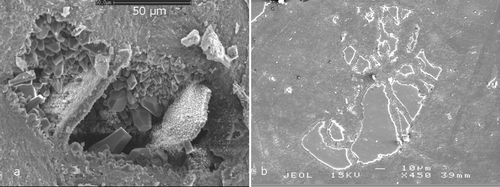
A significant proportion of pisoliths (≈60%) contain fragments of layered or earthy pisoliths in their core. Many of these have more than one fragment, each separated by an unconformity defined by layers within the fragments or disjunctions in the crack patterns ( , e). Simple layered cores are more common at East Weipa (35%) than at Andoom where they comprise only 15%.
Oolith-cored pisoliths make up about 15–20% of the pisoliths from the Weipa Plateau. They occur in more or less equal abundance through the Bauxite Zone and across all the pisolith size ranges. The inner core of these pisoliths is made up of ooliths and fragments of larger pisoliths set in a fine-grained matrix ( , i).
Any of the various types of cores may have a vitreous lustre and be much harder (6–7 on Moh's scale) than other cores ( , d, h). At East Weipa about 18% of the total pisoliths contain fully or partially vitreous cores whereas at Andoom very many fewer (7%) are vitreous.
As is evident from the foregoing description of the pisoliths, the core may be surrounded by one or more cortices. Counting cortices is fraught with difficulty, as the only characteristics that define them are colour and porosity (or surface roughness), and both these characters may change either abruptly or gradually. Some cortices viewed by binocular microscopy appear distinct, while others have gradational boundaries; colour is the obvious discriminator. Under SEM the cortices can be seen to be much finer than optical microscopy shows ( ).
At Jewfish, the outer cortex on the pisoliths is pale cream-coloured, as is the whole mine pit ( ); inner cortices are either cream-coloured or brown, and the cores range in colour from grey-white through cream and pink to orange-red. Most commonly across the plateau there is a red-brown, rather porous, outer cortex, and it is this cortex which gives these pisoliths their typical red-brown colour. In the upper metre of the bauxite, many of the smaller (<2 mm) particles have only a single red-brown cortex, included among these are lumps of earthy matrix, somewhat irregular fragments of hematitic bauxite and at Grunter, quartz grains.
Deeper in the Grunter and Jacaranda profiles, almost all particles have at least two cortices, an outer red-brown and inside that a white or cream, less-porous cortex. Again, smaller particles generally have fewer cortices, but there are nonetheless many pisoliths up to 8 mm in diameter having earthy or oolithic cores and only two or three distinct cortices ( ). Other pisoliths may have cortices continuing as far as the resolution of the binocular microscope, though these are rare.
The cortical layering is most clearly evident because of variations in the Fe-oxyhydroxide content and the porosity of each layer. In backscattered SEM images these layers show as contrasting shades of grey ( ). The layering may also be outlined by small voids formed where quartz silt has been wholly or partially dissolved (). Energy-dispersive electron microprobe analyses show variations in Fe2O3 content across most pisoliths ranges from 0 to over 30% although the cores of some pisoliths are highly hematitic.
Figure 8 Oolith from the Jacaranda pit, Andoom (ANU 46580) with Fe2O3 wt% (anhydrous) shown across the oolith. Variation in grey scale relates to variation in both Fe2O3 and porosity.
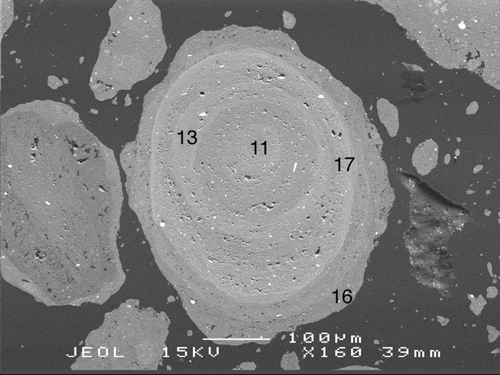
Figure 9 Backscattered electron SEM image of a pisolith from the Longtom pit, East Weipa showing a circular zone of voids (black spots).
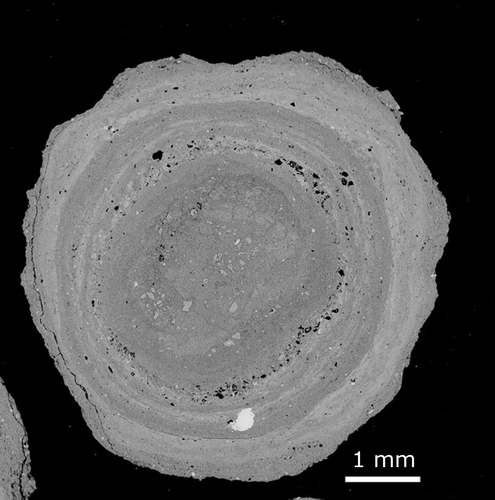
The basal 20 cm of the Bauxite Zone at Skardon River contains pisoliths with varying degrees of development from those containing broken pisolithic cores and gibbsite pseudomorphs of quartz sand to very earthy soft-cored pisoliths with thin and soft cortices, typical of those found below in the Mottled Zone.
The Mn-pisolith accumulations on the floor of Chin Chin pit occur as round outcrops enclosed by normal aluminous pisoliths. (Taylor et al. Citation2008). The Mn-pisoliths are large (∼6–10 mm), black with a dull lustre. Altogether some 10 similar outcrops occur in the vicinity but have not been observed elsewhere at East Weipa or Andoom.
The Mn-pisoliths are well rounded, soft by comparison with aluminous ones with better-defined layering. They consist of kaolinite (∼50%), lithiophorite (∼35%), gibbsite (∼5%) and hematite (∼5%). They have earthy cores surrounded by a number (<20) of cortices and are typified by concentric circular cracks. Additionally their cortices vary in width from ∼100 μm to 1 mm, are rarely continuous and are rather irregular or wavy ( ). In number, width and irregularity their cortices differ from those of most bauxite pisoliths.
Pisolith classification
Ferruginous and/or aluminous pisoliths have not commonly been classified, especially in any objective way. Anand & Paine (Citation2002) classified pisoliths and nodules from the Yilgarn into four classes ( ); (i) homogenous with no internal fabric; (ii) lithorelics that have rock fabric preserved in their core; (iii) pseudomorphic (are all secondary minerals but with some original fabric preservation); and (iv) concentric that have multiple cutans surrounding a core. They also commented (Anand & Paine Citation2002 p. 72) that ‘Concentric cutans may include microlenses of detrital quartz, suggesting a complex history of their formation.’
Figure 11 Classification of ferruginous nodules and pisoliths from the Yilgarn Craton (from Anand & Paine Citation2002 figure 67).
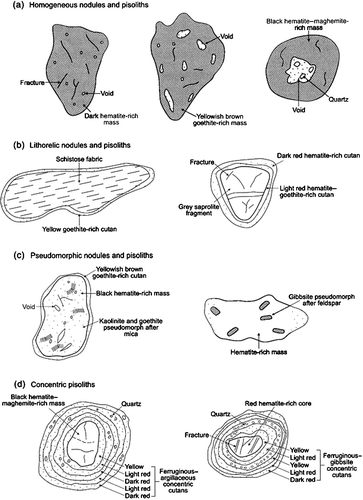
Rio Tinto Aluminium geologists classified the Weipa bauxite pisoliths into 11 types: (i) ferruginous, dominantly from Andoom, have a dark ferruginous core and a thin orange-red cortex; (ii) dull concentric are the most common, and they are well rounded with high sphericity and have a small core, extensive concentric banding surrounding the core and a thin orange weathered rim; (iii) dull non-concentric, restricted to Andoom, lacking internal structure and having a thin weathered coat; (iv) banded, similar to dull concentric but with more distinctive banding and commonly a vitreous core and radial veins; (v) vitreous, hard with a vitreous core; four subgroups are described on the basis of core colour—white, light-brown, dark and yellow banded; (vi) sandy-cored show a distinct texture contrast between a porous core with quartz grains and the surrounding concentric bands; (vii) film coatings are distinguished by the presence of white films on cracked pisolith surfaces; internal cracks are common; (viii) grain pisoliths have great variation but at some stage contained quartz grains; three types of grains are recognised—quartz, white alumina and clear alumina; (ix) oolitic pisoliths again have three subgroups, all having a core of ooliths; the oolith core may be green, various colours but densely packed or dispersed; (x) cellular pisoliths are porous with a lack of internal structure, finer grained at Andoom than at East Weipa; and (xi) compound pisoliths are large (up to 5 cm), hollow and with a knotty outer appearance.
shows a classification developed in this study for the pisoliths of the Weipa Plateau using observations made at up to ×20 magnifications, so that it is a classification applicable in the field as well as microscopically. All the terms used in the classification are described in the descriptions of pisoliths.
Ooliths and finer material
Fine-grained materials (<2 mm) make up a relatively small proportion of the Bauxite Zone but are more varied than the coarser components. The majority of the material in fines is composed of shards or fragments from larger pisoliths which may or may not exhibit layers ( ). This fraction on the Weipa Peninsula contains abundant quartz grains. Ooliths are abundant in some localities () but make up a small component overall. Redsoil is largely made up of fine-grained material, and is described separately below.
Figure 13 (a) Optical micrograph of the 0.5–1 mm size fraction from Grunter B at 2.7 m below the top of the Bauxite Zone in East Weipa (ANU 46582). (b) Optical micrograph of the 0.5–1 mm size fraction from Jacaranda at Andoom sampled at 2 m below the top of the Bauxite Zone (ANU 46580). Ooliths are very abundant in this sample. (c) Optical micrograph of ooliths of different size from the Jacaranda pit (ANU 46580). (d) A Jacaranda oolith in light and (e) the same oolith in SEM image showing continuous cortical zonation to the limit of resolution (ANU 46580). (f) A zoned oolith from Andoom (ANU 46580). (g) SEM image of an 0.6 mm oolith from Andoom (ANU 46580) with a large rounded fragment as core and several irregular cortices. (h) SEM image of two ooliths from Andoom (ANU 46580); the left having a uniform core and a thin cortex, the right having an earthy core and several irregular cortices. Both (g) and (h) also show numerous small particles, some zoned, others not.
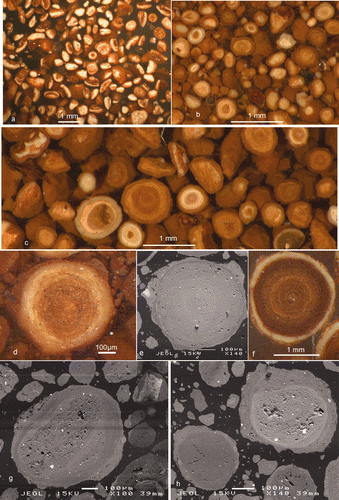
Figure 14 Cemented bauxite. (a) Optical thin-section from Messmate West pit, Andoom (ANU 56354), showing several small pisoliths, clay-sized masses of Fe-oxyhydroxide pellets, voids and quartz. (b) SEM image of an etched quartz grain from the Jacaranda pit, Andoom (ANU 46580). (c) Cemented bauxite showing the replacement of quartz by gibbsite from Messmate East pit at 1.3 m below surface (ANU 56364). (d) Voids after ?quartz wholly or partially filled with well crystallised gibbsite in the cemented bauxite from Messmate West pit (ANU 56354).
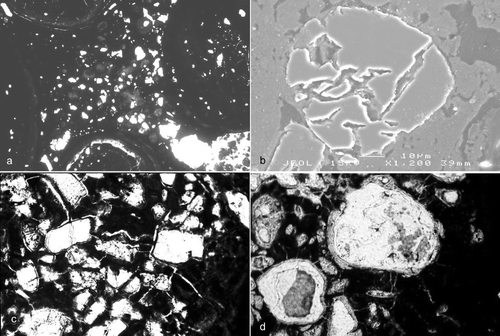
Ooliths are distinguished from pisoliths arbitrarily on the basis of size—ooliths are spherical particles <2 mm in diameter (Eggleton Citation2001). Ooliths in the bauxite are little different from the pisoliths except for size. , c show ooliths of different sizes from about 0.1 to 1 mm. The degree of complexity in their zoning appears to increase with their size; several of the larger ooliths clearly have discordant cores. In the descriptions of particle mineralogy and chemistry below we have not specifically distinguished ooliths from pisoliths.
Cemented bauxite
Cemented bauxite is very little different from the uncemented majority from the Bauxite Zone massive bauxite with respect to the pisolith composition ( ). The cement is aluminous, the matrix is essentially composed of earthy clay-sized masses, ooliths, pellets and fragmented pisoliths, and quartz. While quartz is more common in cemented bauxite at East Weipa it is also relatively more common compared with the massive bauxite at Andoom.
Cemented parts of the pisolitic zone occur throughout the profile but are more commonly found near the top of the bauxite. Three samples, two from Andoom and one from East Weipa have been petrographically examined.
The pisoliths in each cemented sample are typical of those across the Weipa Plateau, with two exceptions: first, they are darker shade of red, and second, they have been significantly altered with most showing evidence of solution of some components, particularly quartz ( , c, d) and their complete or partial replacement with coarsely crystalline gibbsite (). SEM analysis shows the cements to be predominantly aluminous (55–60% Al2O3) with <5% each of silica and Fe2O3.
Redsoil and reworked bauxite
Redsoil is a term used by Rio Tinto Aluminium to refer to a fine-grained bauxite ore found in the Andoom deposit ( ). Redsoil is characterised by abundant ooliths but few pisoliths, and a high content of fine-grained material (75% finer than 0.5 mm). The ooliths have layers of banded cutans, some have white cores. There are also small pisoliths, broken pisoliths, charcoal fragments and plant tissue, all set in a clay-sized matrix. Quartz grains occur in the matrix and in some of the larger ooliths, although commonly only in a few of those in any thin-section. Quartz grains are about 0.2 mm in diameter, are cracked and commonly pitted or etched. Redsoil is very rich in boehmite compared with the main bauxite, and contains more quartz and kaolinite than most Andoom bauxite ( ). The contact of the bauxite with the soil or redsoil may be sharp or gradational.
Table 2 Mineral composition (%) for redsoils, Andoom (poorly-diffracting material not assessed).
‘Reworked bauxite’ is another Rio Tinto Aluminium term, used for surface and near-surface bauxite with a high proportion of fines (<2 mm) as well as broken pisoliths and cemented bauxite fragments ( ), but not a term used by us.
Redsoil and reworked bauxite occur irregularly distributed as elongate lenses up to 2 km long and 5 m thick in and above the pisolithic bauxite, contained in well-defined drainage channels. Redsoils near the surface presently occur in topographically low positions ( ) and are known mostly from the Andoom region.
Figure 17 (a) Digital terrain model (with strong vertical exaggeration). (b) Contour map of the Andoom area showing topography and the distribution of redsoil.

In some places a layer of cobbles lies at the base of the redsoil, overlying massive pisolithic bauxite ( ). Laterally, redsoil bodies thin and grade laterally into massive bauxite.
Particle size distribution
shows the size distributions for bauxite from the Jacaranda pit profile, Andoom and the Grunter B profile, East Weipa. At Jacaranda (), the 0 m sample has a mode at about 3 mm, the other levels all show a mode at about 5 mm. By far the bulk of the particles fall into the size range 8–1 mm: 65% at 0 m, increasing to 90% at 3 m. There is a corresponding decrease in the amount of coarser (>8 mm) particles down profile. The 0 m sample has the greatest quantity of >9.6 mm particles (13%), and of <1 mm particles (19%). The other levels have 1–4% >9.6 mm and about 10% <1 mm.
The particle size distribution for the Grunter Profile ( ) is similar to that at Jacaranda, except that the surface sample has much less fine material (<2 mm) and there are more particles in the >6 mm size fraction in the upper 1 m of the profile.
The modal grainsize of redsoil is between 0.1 and 0.6 mm, making it very much finer than the pisolithic bauxite, which has a mode at about 5 mm. shows grainsize graphs down the redsoil profile at Meeka pit, Andoom. It is clear that the redsoil mode changes sharply between 0.5 and 1 m as the percentage of normal sized bauxite particles (pisoliths) increases. In other words, the redsoils form a fining-upward sequence. The grading defines rather vague bedding, but pebble layers in some places define strongly developed bedding ().
Aspect ratio
An obvious feature of the Weipa pisoliths is their roundness, and any interpretation of the bauxite must include an explanation of this. Measurement shows that almost no pisoliths are actually spherical, about half have their maximum diameter 15–20% greater than their minimum and a significant minority (10%) deviate from sphericity by 50%. Grunter pit (East Weipa) pisoliths are less spherical than are Jacaranda (Andoom) pisoliths ( ).
Specific gravity
The average pisolith specific gravity decreases down profile, from 2.76 at 0 m to 1.95 at 4 m. Within a sample, large pisoliths range in specific gravity by about 0.4 ( ).
Figure 22 (a) Relationship between depth and specific gravity for individual pisoliths from the 8–5.66 mm size fraction, Jacaranda pit, Andoom. (b) Relation between pisolith size and density at levels 0 m to 4 m, Jacaranda pit, Andoom.
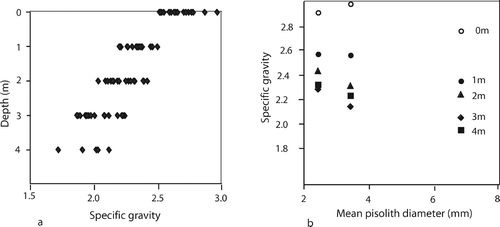
Specific gravity at Jacaranda also varies with pisolith size, being greater for smaller pisoliths ( ). Density changes with size and depth within the Grunter profile at East Weipa in a generally similar manner, though we have rather fewer measurements.
Pisolith mineralogy
In addition to analyses of size fractions of bauxite particles, analyses of two suites of 21 randomly chosen pisoliths from eight different sites at each of East Weipa and Andoom were made ( ). Although the sum of the alumina minerals (S alumina) has only a small range, the distribution among these varies from 100% gibbsite in two pisoliths to 90% boehmite in one pisolith and 90% poorly-diffracting material in another. Poorly-diffracting material is significant (>20%) in half the East Weipa pisoliths analysed and in one-third of those from Andoom, and more of these are found in the upper part of the profile than deeper ( ). Hematite is more abundant in the Andoom suite, while kaolin and quartz are more abundant in the East Weipa suite.
Figure 23 Poorly-diffracting material (PDM) content of individual pisoliths and sample depth. (a) East Weipa. (b) Andoom.
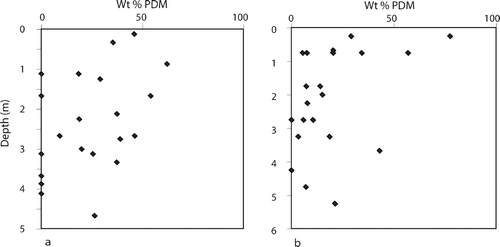
Table 3 Results from analysis of 21 individual pisoliths from each of East Weipa and Andoom.
Six pisoliths from East Weipa were sectioned, and samples taken from the core and the cortex. Results are shown in . The cores of pisoliths remaining after two days in a gem tumbler had a much higher poorly-diffracting material content (50–70%) than the whole pisoliths (typically <20% poorly-diffracting material). Beach gravel from Hey Point was also analysed, and both the >5.6 mm and <5.6 mm fractions contained 25% poorly-diffracting material.
Table 4 Poorly-diffracting material content of core and cortex for six East Weipa pisoliths.
Mineral composition: bulk samples
In the Jacaranda pit profile, the total of the alumina minerals gibbsite, boehmite and poorly-diffracting material increases from about 75% at the top of the bauxite to 85% at 4 m depth. Kaolinite and hematite both decrease down the profile ( ) antipathetically with the alumina minerals. There is a small increase in kaolinite at 4 m.
Figure 24 Variation in poorly-diffracting material (PDM), hematite and kaolin content with depth. (a) Grunter A. (b) Grunter B. (c) Jacaranda.

There is about twice as much kaolinite in the Grunter profiles as there is at Jacaranda ( ), and appreciably more poorly-diffracting material. The trends for these minerals at Grunter are broadly similar to those at Jacaranda but more erratic at Grunter B. There is approximately half as much hematite at Grunter as at Jacaranda, though it shows a similar decrease with depth. Quartz, which is absent at Jacaranda, and only reaches 2% at the top of Grunter A, amounts to 12% at the top of Grunter B, declining steadily to about 1.5% at the base of the bauxite.
In bulk samples of all seven profiles examined in detail, boehmite content decreases with depth while gibbsite increases antipathetically ( ; ). At Jacaranda, the slight decrease in boehmite at 0 m relative to its content at 0.5 m is balanced by increased poorly-diffracting material at 0 m. Poorly-diffracting material itself is only significant above 1 m, reaching 18% in the 0 m sample.
Figure 25 Variation of boehmite and gibbsite in the bauxite profiles. (a) Jacaranda. (b) Grunter A. (c) Grunter B.
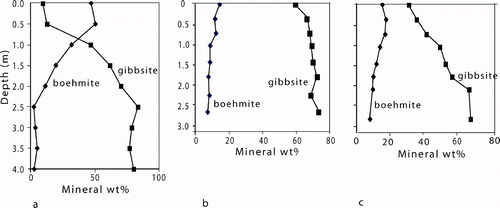
Table 5 Gibbsite content of bulk samples from the top and the base of the bauxite.
Because of the much higher quartz and kaolin at the top of at Grunter A, the total of the alumina minerals is appreciably lower than in the other two profiles.
Although it only occurs as a trace mineral in the Bauxite Zone zircon is present throughout the profile. SEM examination of zircon grains from the bauxite shows it to be highly etched ( ).
Redsoil composition is shown in . Redsoil is strongly enriched in boehmite relative to the pisolithic bauxite, and this enrichment is related to the particle size. Kaolinite in redsoil is generally of the order of 5%, but reaches 15% in some parts of the Meeka profile.
Mineral composition: variation with particle size
Because this deposit is composed of loose, free-flowing pisoliths and ooliths, sieving the samples separates them into discrete particles with very few aggregates. Dry sieving leaves a thin coat of dust on the particles, wet sieving removes some of this. The results here are for dry sieving except for the <4 mm fraction from 0 m which was wet sieved.
At both the Jacaranda and Grunter pits, the mineralogy varies with particle size. This is most evident at Jacaranda, where at any depth, the gibbsite/boehmite ratio decreases linearly as the particle size decreases (log scale), down to 0.3 mm particles, below which size the ratio remains constant ( ). The starting gibbsite/boehmite ratio increases with depth, as described above. The very finest particles at 0 m and 1 m have about 75% boehmite. Hematite increases with particle size, from a low of 2% in the fine fraction at 2 m to a high of 25% in the 5.6–8 mm fraction at the surface.
Kaolinite at Jacaranda is only significant above 1 m and at 4 m. In the dry sieved 0 m sample, kaolin, ∼8% in the bulk sample, is most abundant in particles smaller than 1 mm, amounting to about 15% of that fraction. After prolonged ultrasonic washing, the kaolin content of the <2 μm fraction increased from 9% in the dry-sieved sample to 17%. Possibly many of the fine sand and silt particles include kaolin aggregates that break up on ultrasonic treatment.
Anatase remains constant (∼3%) throughout the Jacaranda profile, both with respect to depth and particle size, except for a small increase toward the finer size fractions.
At the Grunter B pit, the alumina minerals show a reverse trend from that at Jacaranda. In , boehmite + poorly-diffracting material are compared with gibbsite for different particle sizes at three depths. Larger particles have a greater proportion of anhydrous minerals. The trends are complicated by the much higher proportion of quartz and kaolinite, which themselves show a strong dependence on particle size.
Figure 28 Variation of the ratio of anhydrous alumina [boehmite + poorly-diffracting material (PDM)] to all alumina minerals, with particle size, Grunter B pit, East Weipa.
![Figure 28 Variation of the ratio of anhydrous alumina [boehmite + poorly-diffracting material (PDM)] to all alumina minerals, with particle size, Grunter B pit, East Weipa.](/cms/asset/3266cc83-91c1-46db-8022-80a186478619/taje_a_343992_o_f0028g.gif)
In all the Grunter B samples, kaolinite shows a linear increase with decreasing particle size (dry sieved), whereas quartz has a marked mode at about 0.5 mm ( ). Hematite is much more abundant in the particles >1 mm (7%) than in those <1 mm (1.5%).
Figure 29 Variation of quartz (squares) and kaolinite (diamonds) with particle size at 1.4 m in the Grunter B pit, East Weipa.
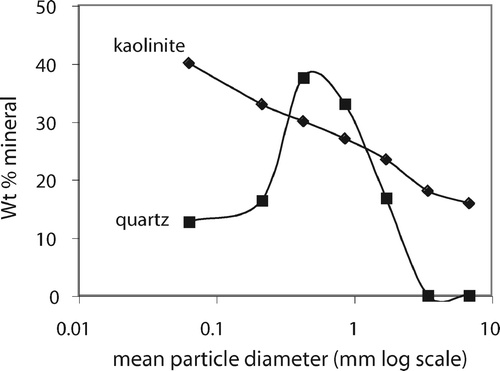
Redsoil shows the same relationship between particle size and boehmite/gibbsite ratio as is found for the Jacaranda samples: namely that finer particles contain more boehmite. shows the boehmite/(boehmite + gibbsite) percentage plotted against the particle size mode for all redsoil samples in this study.
Figure 30 Particle size mode plotted against percentage boehmite in alumina minerals for all redsoils.
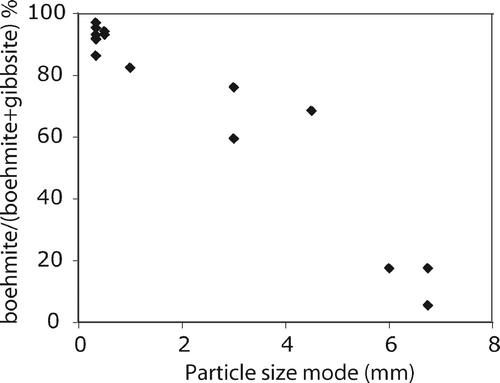
Only a few analyses of mineral distribution across pisoliths were made. In all cases they showed a decrease in boehmite from the outer cortical layer inwards.
Bauxite geochemistry
Samples of pisolithic bauxite from East Weipa (n = 39) and Andoom (n = 38) were analysed for major-element content. Al2O3, SiO2, Fe2O3, TiO2 and H2O make up over 99% of the bauxite. Between 1 and 2% of the H2O is evolved below 110°C, allowing the analytical loss on ignition (LOI) to be a good guide to the relative proportion of gibbsite, since this is the major hydrous mineral in the bauxite [gibbsite has 35% H2O, boehmite 14%; goethite content (10% H2O) is generally below 1%]. shows LOI from three profiles at East Weipa, and from 10 Andoom profiles. Some of the scatter in may arise because the base of the bauxite is at a different depth in different places, but a general trend toward increased hydration with depth is evident for the pisolithic bauxite. For redsoil (squares in ) there is much less change in the hydration state of the samples.
Figure 31 Loss on ignition (LOI) vs depth for (a) three East Weipa pisolithic bauxite profiles and (b) eight Andoom bauxite profiles (diamonds) and two redsoil profiles (grey squares).

shows the analytical results recalculated on an anhydrous basis in the form of histograms. The range of values for Al2O3 and TiO2 are very narrow for such a large deposit. Greater Fe2O3 at Andoom, and greater SiO2 at East Weipa provide a contrast between these two parts of the deposit.
Magnetic susceptibility
Some pisoliths and ooliths are sufficiently strongly magnetic to be picked up by a hand magnet. These contain up to 15% maghemite.
Bulk magnetic susceptibility at Jacaranda for the >4 mm and <4 mm fractions decreases exponentially with depth ( ); the fitted curves have R2 = 0.96. Magnetic susceptibility also increases as particle size decreases.
Age
Grains of charcoal occur through the redsoils, and three samples provided sufficient material for a 14C age ( ). These data suggest the redsoil profiles are at least 5–10 ka.
Table 6 14C ages for redsoil carbon, Andoom.
Discussion
The Weipa Plateau covers some 11 000 km2 of western Cape York, a large area by any calculation. This plateau is to a large extent covered by thicker or thinner Bauxite Zone materials consisting mainly of loose pisoliths, which change little in their character from place to place. Although in this paper most of our data are from the region of the Rio Tinto Aluminium mines, from a field perspective the Bauxite Zone varies little across the whole plateau or within the mine lease and, as discussed by Taylor et al. (Citation2008), this is remarkable.
Pisoliths have a modal size of 5 mm across the plateau ( ), regardless of the underlying bedrock. There is a slight tendency for nodules to be more common in the upper parts of the profile. Fine material is typically more common at Andoom where there is more redsoil. Despite the remarkably uniform material from which the Bauxite Zone is composed there are only three commonly occurring facies within this huge mass of pisoliths: (i) massive bauxite that exhibits little or no structure except bioturbation features including most commonly root tubules and termite galleries; (ii) cemented bauxite that is simply massive bauxite with an Al/Fe-rich cement; and (iii) redsoil that is a fine-grained graded bed of bauxite debris, ooliths, pellets and clay that sits on erosional surfaces in the massive facies, particularly where it overlies the Rolling Downs Group; at one locality at least it is cross-bedded ().
In we presented an objective classification of Weipa pisoliths and one which, although presented rather differently, concurs in its descriptive characters with those of the Rio Tinto Aluminium classification. We have converted these observations into our interpretation of their genetic significance and this is shown in . This shows clearly that the pisoliths form from a variety of core materials (earth lumps, earlier pisoliths, broken pisoliths, and oolith accumulations being the common ones). These accrete cortices at different places and at different times in different environments, causing variation in the Fe-content of each cortex. They may be reworked causing breakages or eroded causing internal unconformities and may be weathered forming the brown coloured rims on cores described above. Pisolith formation is a multi-staged process involving many episodes of reworking and accumulation. This is discussed in more detail in Taylor & Eggleton (Citation2008).
The presence of redsoils in topographical lows on the plateau surface point to them being comparatively recent deposits in the time frame of the evolution of the whole deposit. That they contain broken pisolith shards, ooliths, pellets and earthy clay lumps also suggests they represent comparatively recent reworkings of the materials making up the Bauxite Zone. The 14C ages from them confirm this.
The aspect ratio of pisoliths shows them to be very spherical. We interpret this as simply the result of accretion, as the accretion of equal thickness cortices can change an irregular or elongate particle toward having a spherical shape, as has occurred, for example, to the angular fragment in the centre of the pisolith shown in . Thickening of an accreted layer over depressions in the core will further develop sphericity. Simple layered pisoliths are more spherical than most because their cortices accumulate around a spherical or subspherical core (), perhaps even a single oolith.
In the Mottled Zone and in the cemented pisolith facies it is common to observe matrix (plasmic) material that has been divided into small (<1 mm) blocks or lumps of clay-size materials ( ). Some are partially rounded. This feature is thought to originate from expansion and contraction of the plasmic material caused by either repeated volume changes that accompany repeated mineralogy changes or by repeated wetting and drying. Such rounded blocks may then form the cores of earthy cored pisoliths.
Figure 35 Optical thin-section view of the matrix between pisoliths where the matrix has been transformed into a series of blocky lumps of clay-sized earthy material surrounded by cutans. Field of view is 4 mm wide. From Ash pit, Andoom (ANU 46624).
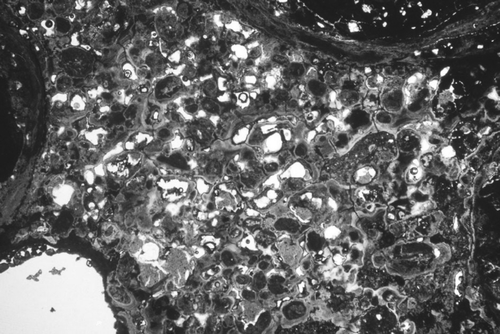
It is also possible that transport and erosion of pisoliths may round them, and that after their deposition they are more spherical and continue to accumulate additional cortices. This will, perhaps in combination with continued cortication, result in more spherical pisoliths.
Pisolith specific gravity increases towards the surface ( ) which must result either from an increase in the proportion of higher specific gravity minerals they contain or a decrease in pore space. The higher specific gravity minerals are boehmite, poorly-diffracting material and hematite and/or maghemite. Also at Jacaranda specific gravity decreases with pisolith size () suggesting that either larger pisoliths have more voids than smaller ones or they have a different mineralogical composition.
That density change is caused at least partly by change in alumina mineralogy is evident in which shows a good correlation between average mineralogy and density for larger pisoliths.
Figure 36 Relationship between the specific gravity of the larger pisoliths and their percentage content of the denser minerals [boehmite + hematite + poorly-diffracting material (PDM)].
![Figure 36 Relationship between the specific gravity of the larger pisoliths and their percentage content of the denser minerals [boehmite + hematite + poorly-diffracting material (PDM)].](/cms/asset/4c47d00e-f1d7-433e-9864-1ccc241929c6/taje_a_343992_o_f0036g.gif)
From average density measurements of pisoliths in several size ranges, and their mineralogy, porosity (%) was estimated ( ). Pisolith porosity is about 21% at 0 m and 2 m, and rather higher (∼30% at 3 m).
Table 7 Calculated porosity (%) of various sized pisoiths.
The Bauxite Zone, and hence the pisoliths, are made up of a relatively small suite of minerals: gibbsite, boehmite, hematite and kaolinite, with minor quartz, goethite, maghemite and anatase. Although the mineralogy is simple, it varies consistently through the Bauxite Zone profile, with boehmite and poorly-diffracting material more prevalent near the surface while gibbsite is common deeper in the profile ( , 28). Boehmite throughout the Andoom Bauxite Zone is more common in smaller pisoliths and fine-grained material (). It is clear that either boehmite crystallises in preference to gibbsite near the surface, or gibbsite dehydrates to form boehmite near the surface and in finer-grained materials, or that boehmite hydrates to gibbsite at depth. Perhaps this variation occurs because near the surface water is present for relatively short times annually and because the size of the fine particles allows more rapid water loss. Dehydration of gibbsite at temperatures less than 60°C (the maximum recorded from exposed dark rocks on sunny days: Shirtliff Citation2007) has never been reported. This observation taken with the increase in magnetic susceptibility () near the upper parts of the profile (i.e. increased maghemite content) and the increase in poorly-diffracting material near the surface suggests that fire may be the cause of dehydration of gibbsite as well as of the conversion of goethite/hematite to maghemite. This topic is considered in more detail in Eggleton & Taylor (Citation2008b).
Mineralogical variation in individual pisoliths
Particles from the Jacaranda profile show increasing boehmite with decreasing particle size ( ). The fine fraction (<75 μm) from 0 and 1 m samples at Jacaranda are very high in boehmite (75% and 65%, respectively), as are all particles smaller than 0.3 mm in diameter. The outer cortex of Jacaranda pisoliths is between 0.1 and 0.2 thick, and is very similar to the fine fraction in both colour and composition. The results shown in we interpret as indicating the presence of an outer cortex averaging 0.15 mm in thickness composed of strongly adhering fines from the surrounding fine matrix. Calculated compositions for Jacaranda, based on a model in which a pisolith of boehmite content equal to that of the average large pisolith at that level is coated by a cortex 0.14 mm thick having the same boehmite content as the matrix, are compared with actual compositions in . For simple geometric reasons, the outer, boehmite-rich, cortex comprises a smaller percentage of the volume of a large particle than of a small one; thus total boehmite decreases with increasing particle size. The outer cortex seems to have accreted from the fine matrix in which the particles lie. Furthermore, particles smaller than 0.3 mm may themselves have formed entirely from this fine fraction.
Table 8 Composition of particles from 0, 1 and 2 m depth in the Jacaranda Pit, Andoom.
At the Grunter pit, East Weipa, the fine fraction (<125 μm) contains a high proportion of kaolinite (30–50%), and the percentage of kaolinite decreases with increasing particle size ( ). We interpret this in exactly the same way as at Jacaranda—the outer cortex comprises a larger percentage of the smaller particles than of the large ones, and is simply an accreted layer of the surrounding matrix.
At Jewfish, the outer cortex is cream-coloured, very different from the colour across most of the Weipa Plateau, but as at Jacaranda and Grunter, this cortex is exactly the same in appearance as the matrix. There is almost no iron in the Jewfish bauxite. Why this is so may be because the pit is under water during the wet season (note the horizontal micro-terraces on the pit wall in ). An annual period of immersion may lead to locally reducing conditions during the wet season. For whatever reason, pisoliths at Jewfish have acquired a cream-coloured outer cortex. At Skardon River, there is pure white pisolithic bauxite associated with the low-lying kaolinite deposit. The cores of these pisoliths are very porous, in some instances the pisoliths are almost hollow shells, and this, together with their whiteness, suggests hematite or goethite has been leached from them.
We conclude that the very common white second cortex on most of the Weipa pisoliths was formed at a time when a far wider region of the plateau experienced an iron-free environment. This could relate to a time of a higher than present water-table if saturation and reduction of iron is the explanation. Another possibility is that the white cortices result from reduction by organic matter, and so reflect a period of greater abundance of plant and animal material (White Citation1976). The white bauxite at Skardon River and the pale Jewfish pit probably also result from reductive leaching of iron.
The deposit is an aggregate of relatively large loose particles in mutual contact, with finer material in interstices. It does not consist of pisoliths supported in a fine matrix. This is supported by the observation of dimples on the surface of in situ pisoliths at the point of contact with their neighbours ( ) and these dimples also explain the presence of lenticular cortices which are so common in many pisoliths. Dust accreting on the pisoliths only coats those parts of the pisolith exposed in voids within the Bauxite Zone so producing a discontinuous cortical layer.
Figure 37 Exposed surface of a weakly cohered block of pisoliths from Rikkara, Andoom, showing areas of contact between adjacent pisoliths as darker patches.
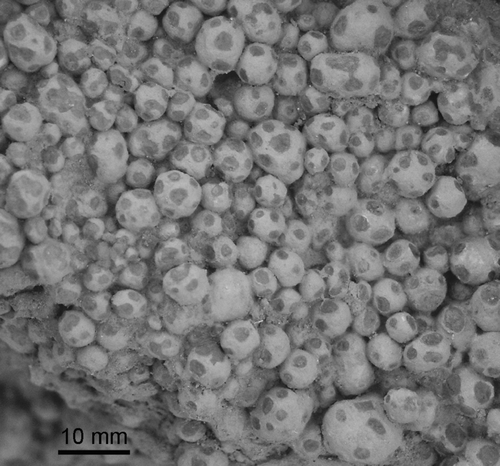
Below the ironstone layer (lateritic duricrust) the chemical composition changes smoothly with depth, in contrast to the uniform chemistry of the bauxite. We have argued (Eggleton et al.Citation2008) that the whole Andoom profile is the result of in situ leaching of Rolling Downs Group bedrock. We have shown that the bauxite overlying Rolling Downs Group is chemically and mineralogically distinct from that at East Weipa overlying Bulimba Formation. Despite the clear connection of Andoom bauxite to its substrate, we conclude that the particles, and particularly the pisoliths, cannot have formed where they now lie, and must have accumulated, probably by local overland transport, after release from the upper Mottled Zone (Transition Zone) where they grew as matrix-supported particles.
Conclusions
Observations from the Weipa Plateau, mainly at East Weipa and Andoom clearly show the following.
(1) The Bauxite is made up of spherical particles (pisoliths) with a median size of ∼5 mm and a fine tail making up about 5–10% of the material.
(2) The Bauxite has a coarse component (nodules) of ovoid larger particles with a remarkably consistent size (∼30 mm long and ∼20 mm in diameter).
(3) There is no preferential distribution of the various particles through the profile.
(4) The fine material is made up of spherical particles <2 mm in diameter, fragments of larger particles, and sand-, silt- and clay-sized material, and is largely composed of gibbsite, boehmite and kaolinite.
(5) The Bauxite is overlain by soil that in most places is mixed with the upper portion of the Bauxite over about 30 cm.
(6) In places it is overlain or contains within it unconformably the redsoil, a fine-grained facies, rich in Al2O3.
(7) The Bauxite overlies a ferricrete with a sharp or gradual contact. In the latter case the Bauxite contains soft earthy pisoliths mixed with pisoliths similar to those in the body of the deposit.
(8) The nodules, pisoliths and, to a lesser extent the, ooliths vary internally from simple structures with a central earthy core and a sequence of cortical layers to very complex entities with a number of internal unconformities, both of the core and cortex.
(9) Pisoliths can be classified according to their internal fabrics.
(10) The external appearance of pisoliths has little relationship to their internal fabric.
(11) The nodules are generally hollow or filled by finer pisoliths, ooliths and other components of the Bauxite.
(12) Redsoil is rich in boehmite and is composed of small pisoliths, ooliths and mud-sized fragments and small lumps of matrix from the bauxite. It may contain coarser pisoliths and nodules, particularly towards the basal surface of the redsoil.
(13) Within the Bauxite, pisoliths grow by cortical accretion by the addition of cutans or perhaps by precipitation.
(14) The particles, and particularly the pisoliths, cannot have formed where they now lie, and must have accumulated, probably by local overland transport, after release from the upper Mottled Zone (Transition Zone) where they grew as matrix-supported particles.
Notes
*A three dimensional compound unit within the matrix of a soil material, or occurring as a discrete physical fabric element, generally approximately equant or prolate in shape and with a sharp boundary: Eggleton 2001.
References
- Anand , R. R. and Paine , M. 2002 . Regolith geology of the Yilgarn Craton, Western Australia: implications for exploration . Australian Journal of Earth Sciences , 49 : 3 – 162 .
- Boulangé , B. 1984 . Les formations bauxitiques lateritiques de Cote d'Ivoire: les facies, leur transformation, leur distribution et l'évolution du modelé . Travuax et Documents de l'ORSTOM , 175
- Eggleton R. A. 2001 The regolith glossary. Surficial geology, soils and landscapes Cooperative Research Centre for Landscape Evolution and Mineral Exploration Canberra
- Eggleton , R. A. and Taylor , G. 2008a . Effects of some macrobiota on the Weipa Bauxite, northern Australia . Australian Journal of Earth Sciences , 55 ( Supplement ) : S71 – S82 .
- Eggleton , R. A. and Taylor , G. 2008b . Impact of fire on the Weipa Bauxite, northern Australia . Australian Journal of Earth Sciences , 55 ( Supplement ) : S83 – S86 .
- Eggleton , R. A. , Taylor , G. , Le Gleuher , M. , Foster , L. D. , Tilley , D. B. and Morgan , C. M. 2008 . Regolith profile, mineralogy and geochemistry of the Weipa Bauxite, northern Australia . Australian Journal of Earth Sciences , 55 ( Supplement ) : S17 – S43 .
- Morgan , C. M. 1995 . The geology of spheres at Weipa . Travaux de Comité Internationale pour l'Etude des Bauxites, de Alumine et de l'Aluminium , 22 : 61 – 74 .
- Nahon , D. 1976 . Cuirasses ferrugineuses et encroutements calcaires au Sénégal Occidental et en Mauritanie. Systèmes évolutifs: géochemie, structures, relais et coexistence . Sciences Géologiques Memoires Strasbourg , 44
- Nahon , D. B. 1991 . Introduction to the petrology of soils and chemical weathering , Chichester : Wiley .
- Shirtliff , G. 2007 . “ The waste and low grade ore stockpiles of Ranger uranium mine—a systems approach ” . PhD thesis, Australian National University, Canberra (unpubl.) .
- Tardy , Y. 1997 . Petrology of laterites and tropical soils , Rotterdam : Balkema .
- Taylor , G. and Eggleton , R. A. 2008 . Genesis of pisolith and of the Weipa Bauxite deposit, northern Australia . Australian Journal of Earth Sciences , 55 ( Supplement ) : S87 – S103 .
- Taylor , G. , Eggleton , R. A. , Foster , L. D. and Morgan , C. M. 2008 . Landscapes and regolith of Weipa, northern Australia . Australian Journal of Earth Sciences , 55 ( Supplement ) : S3 – S16 .
- Tilley , D. B. 1994 . “ Models of bauxitic pisolith genesis: data from Weipa, Queensland ” . Canberra : PhD thesis, Australian National University . (unpubl)
- Tilley , D. B. and Eggleton , R. A. 1995 . Tohdite (5Al2O3.H2O) in bauxites from northern Australia . Clays and Clay Minerals , 42 : 485 – 488 .
- Tilley , D. B. and Eggleton , R. A. 1996 . The natural occurrence of eta-alumina (η-Al2O3) in bauxite . Clays and Clay Minerals , 44 : 658 – 664 .
- White , A. H. 1976 . Genesis of low iron bauxite, northeastern Cape York, Queensland, Australia . Economic Geology , 71 : 1526 – 1532 .
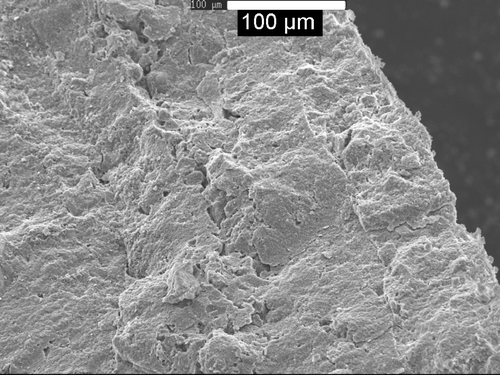
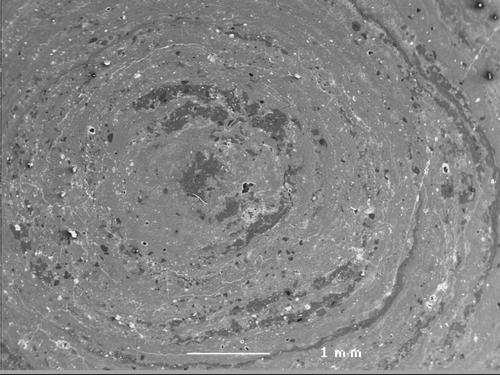
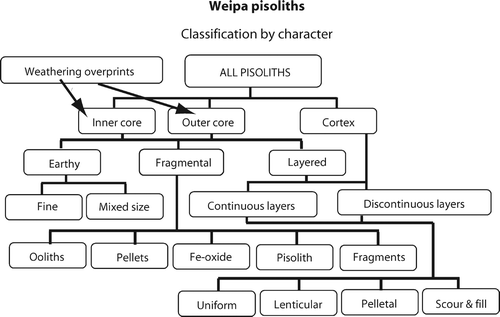
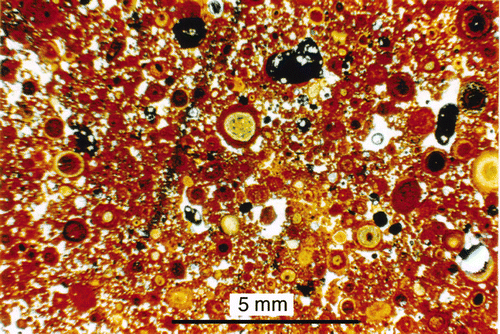
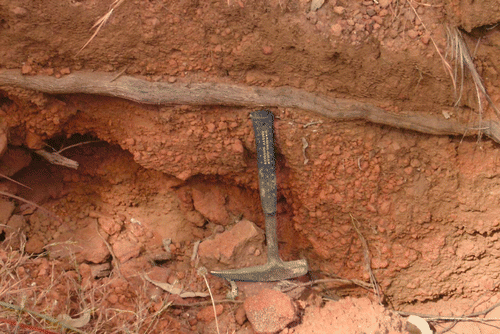
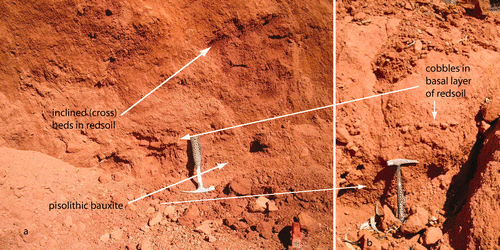

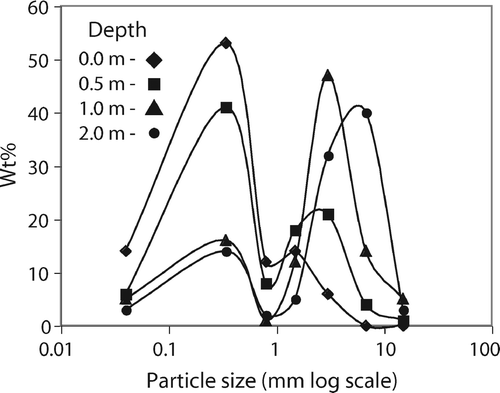
![Figure 21 Degree of sphericity [S = (max–min)/mean diameter: 0 perfectly spherical] for 50 Jacaranda (Andoom) pisoliths (black columns) and 60 Grunter (East Weipa) pisoliths (grey columns). The Grunter pisoliths depart further from sphericity than do the Jacaranda pisoliths.](/cms/asset/48fd827f-fdf2-4876-b926-b3709665ef1d/taje_a_343992_o_f0021g.gif)
